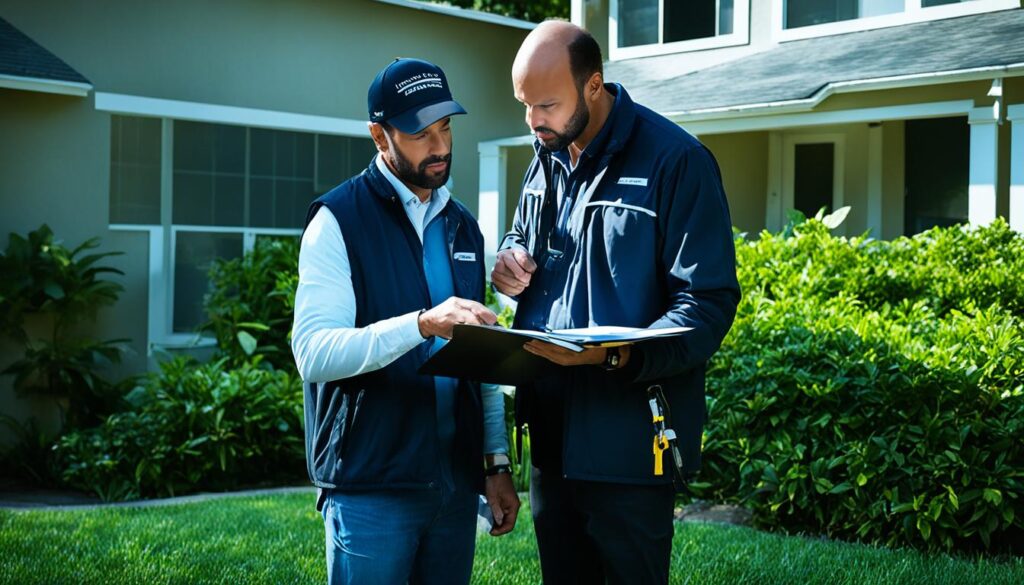Understanding ARV in Real Estate Explained
Hello, my name is [Your Name], and I am a professional in the real estate industry. In this article, I will provide you with a comprehensive explanation of ARV, or after repair value, in real estate.
ARV is a critical metric that plays a crucial role in determining the estimated value of a property after it has been renovated or repaired. This value is essential for investors as it helps them accurately assess the potential value of properties and make informed investment decisions.
By understanding ARV and how it is calculated, you can gain insights that will benefit your real estate ventures. So, let’s dive deeper into this topic and explore the various aspects of ARV in real estate.
Key Takeaways:
- ARV, or after repair value, is a crucial metric in real estate that determines the estimated value of a property after it has been renovated or repaired.
- By accurately calculating ARV, investors can make informed investment decisions and assess the potential value of properties more effectively.
- Calculating ARV involves evaluating comparables (comps), appraising the property, and assessing the value of repairs.
- Understanding ARV is important not only for formulating offers but also for obtaining financing for fix-and-flip projects.
- While ARV is a valuable tool, it has limitations, such as variations in comparables and unforeseen issues during renovations, which should be considered during the calculation process.
How to Calculate ARV
Calculating the After Repair Value (ARV) is a fundamental step in determining the potential value of a property. By accurately calculating the ARV, real estate investors can make informed decisions and strategize their investments effectively.
To calculate the ARV, you can use a basic formula that involves adding the current value of the property to the value of renovations:
ARV = Current Value of the Property + Value of Renovations
However, a more accurate ARV estimate requires evaluating comparables, appraising the property, and assessing the value of repairs.
Evaluating Comparables
One crucial factor in calculating ARV is evaluating comparables, also known as “comps.” Comps are recently sold properties that are similar to the property you’re renovating or flipping. By analyzing the sale prices of comparable properties in the same area, you can gain insights into the typical value of renovations and make a more accurate ARV estimate.
Property Appraisal
An essential step in the ARV calculation process is obtaining a property appraisal. An appraiser assesses various factors such as the property’s size, location, condition, and amenities to determine its current value. A professional appraisal helps you obtain an accurate estimation of a property’s worth before and after renovations, ensuring a realistic ARV calculation.
Assessing the Value of Repairs
To calculate ARV accurately, it’s crucial to assess the value of repairs. This involves identifying the necessary repairs and estimating their associated costs. By consulting with professionals and obtaining multiple repair estimates, you can factor in all potential expenses and avoid underestimating or overestimating the value of repairs in your ARV calculation.
By considering these factors and thoroughly analyzing the necessary data, you can calculate a more precise ARV. The ARV formula provides a reliable framework for determining the maximum offer price for a property, allowing investors to make profitable real estate investments.
| Evaluation Factors | Description |
|---|---|
| Comparables (Comps) | Analyze recently sold properties similar to the property you’re renovating to determine the typical value of renovations. |
| Property Appraisal | Obtain a professional appraisal to assess the property’s current value based on various factors such as size, location, condition, and amenities. |
| Assessing Repairs | Identify necessary repairs and estimate their associated costs accurately to factor in all potential expenses. |
Evaluating Comparables for ARV
When calculating the after repair value (ARV) of a property, evaluating comparables, or comps, is a critical step in obtaining an accurate estimate. Comparable properties are those that are similar to the property you are renovating or flipping and have recently sold nearby. Analyzing the sale prices of these comps allows you to gain insights into what is typically paid for similar renovations in the area, which helps you better evaluate the ARV.
By carefully studying the sale prices of comparable properties, you can identify patterns and trends in the market. This information enables you to assess the potential value of your property after repairs and renovations, taking into account the local market conditions. It also helps you determine the extent to which your property’s ARV may be influenced by factors such as location, amenities, and size.
| Important Factors to Consider When Evaluating Comparables | Questions to Ask |
|---|---|
| Property Type | Is the comparable property of the same type as the property you are evaluating? |
| Location | How close is the comparable property to your property? Is it in the same neighborhood? |
| Size | What is the square footage of the comparable property? Is it similar to your property? |
| Condition | Was the comparable property in a similar condition before it was renovated? |
| Sold Date | When did the comparable property sell? Recent sales provide more up-to-date market information. |
By considering these factors and asking pertinent questions, you can select the most relevant comparables to use in your ARV calculation. It’s important to note that the selected comps should reflect properties that are truly comparable to your property, ensuring the accuracy and reliability of your ARV estimate.

By analyzing the sale prices of comparable properties, you can get a more accurate ARV estimate by considering what is typically paid for similar renovations in the area.
The Importance of Property Appraisal in ARV
When it comes to determining an accurate ARV, property appraisal plays a vital role. An appraiser thoroughly evaluates various factors including the overall condition, size, amenities, and location of the property. Through this comprehensive assessment, they provide an estimate of the property’s current value.
Property appraisals are crucial not only before renovations but also after the completion of improvements. These appraisals ensure that the listing price is accurately set and also account for any changes in market conditions, providing a realistic ARV.
Obtaining a property appraisal is a valuable step in the investment process, allowing investors to make more informed decisions by having a better understanding of the property’s value. Whether you are a seasoned real estate investor or just starting out, including property appraisal in your ARV calculation is essential for success.

The Benefits of Property Appraisal in ARV
There are several advantages to incorporating property appraisal in your ARV calculation:
- Accurate Valuation: By relying on the expertise of professional appraisers, you can obtain a precise estimate of the property’s value. These experts consider various factors, ensuring a comprehensive evaluation that leads to a more accurate ARV.
- Eliminating Bias: Property appraisals provide an objective assessment, eliminating personal biases that may influence your ARV calculation. This impartial evaluation helps to maintain an unbiased approach and make informed decisions.
- Market Insight: Appraisers have in-depth knowledge of the local real estate market. Their expertise enables them to factor in market trends and conditions, ensuring that your ARV aligns with current market values.
- Professional Expertise: Appraisers undergo extensive training to accurately determine property values. By leveraging their professional knowledge and experience, you can benefit from a more reliable ARV estimate.
“Property appraisal is an essential element in the ARV calculation process. It provides a reliable assessment of a property’s value, ensuring accurate ARV estimates and informed investment decisions.”
Assessing the Value of Repairs for ARV
When calculating ARV, it is crucial to assess the value of repairs accurately. By doing so, investors can avoid unexpected costs and arrive at a more precise ARV estimate. To assess the value of repairs, an appraiser is essential. They have the expertise to identify repairs that need to be made and estimate the cost associated with those repairs.
However, it is important to approach repair cost estimation with realism. Consider all potential expenses that may arise during the renovation process, such as labor, materials, and unforeseen complications. By accounting for these factors accurately, investors can ensure that their ARV estimation is comprehensive and reliable.
The Role of an Appraiser in Assessing Value
“An appraiser plays a crucial role in assessing the value of repairs for ARV calculations. They are trained to identify necessary repairs and provide cost estimates based on their expertise. Their input is invaluable in ensuring an accurate ARV estimation.”
By leveraging an appraiser’s skills and knowledge, investors can gain insights into the true value of repairs required for a property. This information significantly contributes to making informed decisions and formulating accurate ARV calculations.
When estimating repair costs, it is essential to consider both the immediate expenses and the long-term implications. Failing to account for any overlooked repairs or unexpected issues can lead to financial setbacks and undermine the accuracy of ARV estimates.
Once the value of repairs has been assessed, it can be incorporated into the overall ARV calculation. This ensures that the final estimate considers the potential increase in value resulting from the completed repairs and accurately reflects the property’s post-renovation worth.
| Benefits of Assessing the Value of Repairs for ARV | Considerations for Accurate Repair Cost Estimation |
|---|---|
|
|
The ARV Formula in Real Estate Investing
When it comes to real estate investing, understanding the ARV formula is essential. ARV, or After Repair Value, is a key metric that helps investors determine the maximum offer price for a property. By utilizing this formula, investors can calculate a purchase price that allows for a profit margin while considering the value of repairs.
The ARV formula follows a simple calculation: 70% of the ARV minus the repair cost equals the maximum offer price. Let’s break it down:
Maximum Offer Price = 70% of ARV – Repair Cost
By using this formula, investors can accurately assess the potential profitability of a property and ensure that their offer aligns with their investment goals.
Image:
Here’s an example to illustrate its application:
| Property Details | Estimated Values |
|---|---|
| Current Value | $300,000 |
| Repair Cost | $50,000 |
| ARV | $450,000 |
| Maximum Offer Price | $285,000 |
Based on the example above, if the property’s ARV is estimated at $450,000 and the repair cost is $50,000, the maximum offer price using the ARV formula would be $285,000. This calculation accounts for a profit margin while considering the value of repairs.
By understanding and utilizing the ARV formula, real estate investors can make more informed decisions, analyze potential deals effectively, and structure offers that align with their investment strategy.
ARV and Fix-and-Flip Financing
When it comes to house flipping, ARV (after repair value) plays a crucial role not only in formulating offers but also in securing financing for your fix-and-flip projects. Private and hard money lenders often rely on ARV to determine the maximum loan amount they are willing to provide.
Understanding the concept of ARV helps you craft offers that align with the lending parameters of these financial institutions. By accurately estimating the ARV, you can showcase the potential profitability of your renovation project and increase your chances of obtaining the necessary financing.
One popular approach to fix-and-flip financing is to use ARV-based loans. These loans allow you to borrow a certain percentage of the property’s ARV, providing you with the necessary capital to purchase and renovate the property.
ARV-based loans can be particularly advantageous for house flippers, as they often have more relaxed eligibility requirements compared to traditional loans. These loans are primarily based on the estimated value of the property after repairs, rather than the borrower’s creditworthiness or income.
So, how does this financing process work? Once you have calculated the ARV of your property, you can approach private or hard money lenders who specialize in fix-and-flip financing. They will assess the potential profitability of your project based on the calculated ARV and the scope of renovations needed.
The loan amount approved by these lenders is generally a percentage of the ARV, typically ranging between 70% and 90%. The actual loan percentage varies depending on various factors such as the lender’s policies, your experience, and the local real estate market conditions.
By leveraging ARV, you can not only gain valuable insights into the potential value of your property but also secure the necessary financing to carry out your fix-and-flip project. This financing option allows you to minimize the amount of personal capital required and maximize your return on investment.
| Benefits of ARV and Fix-and-Flip Financing: |
|---|
| 1. Enables you to present a more compelling case to lenders |
| 2. Offers the potential for higher loan amounts |
| 3. Provides an alternative financing option for properties that do not qualify for traditional mortgages |
| 4. Allows you to leverage the property’s potential value to secure funding |
With ARV and fix-and-flip financing, you can overcome the financial challenges associated with house flipping and turn your renovation projects into profitable investments.
Tips for Calculating ARV
Calculating ARV requires skill and practice. To improve accuracy, consider the following tips:
Analyze Comparables Thoroughly
When calculating ARV, it is crucial to analyze comparables (comps) thoroughly. Look for properties that are similar to the one you are assessing and have recently sold in the same area. By comparing the sale prices of these comps, you can gain insights into the market value of your property and make a more accurate ARV estimate.
Obtain Multiple Repair Estimates
Getting repair estimates from multiple contractors or professionals is essential for calculating ARV. Different experts may have different opinions, so obtaining multiple estimates helps you gain a better understanding of the potential repair costs involved. This allows for a more comprehensive analysis and a more accurate ARV calculation.
Consider Additional Costs
When calculating ARV, it is important to consider additional costs such as holding and financing costs. Holding costs include expenses like property taxes, insurance, and utilities that you may incur while renovating or preparing the property for sale. Financing costs take into account the interest and fees associated with borrowing money for the project. Factoring in these additional costs provides a more realistic ARV estimate.
Account for Market Conditions and Seasonal Price Changes
Market conditions and seasonal price changes can significantly impact ARV. It is essential to stay updated on the local real estate market and be aware of any fluctuations in property prices. Additionally, consider how seasonality affects the demand and pricing of properties in your area. By factoring in these factors, you can adjust your ARV calculation accordingly.
Example ARV Calculation Table:
| Property Information | Value |
|---|---|
| Purchase Price | $200,000 |
| Repair Costs | $50,000 |
| Comps Analysis | $250,000 |
| Additional Costs | $10,000 |
| Estimated ARV | $260,000 |
By following these tips and conducting a thorough analysis, you can make more accurate ARV calculations and make informed decisions when investing in real estate.
Drawbacks of ARV
In real estate investing, ARV (after repair value) is a valuable metric that helps determine the potential value of a property after renovations. However, it is important to be aware of the limitations and drawbacks associated with ARV calculations.
One of the main drawbacks of ARV is that it relies heavily on accurate comparables and repair estimates. Evaluating comparables involves finding properties that are similar to the one being renovated and have recently sold in the same area. However, the accuracy of these comparables can be subjective and may not always provide an accurate representation of the property’s value.
Additionally, estimating repair costs can also be a challenge. While an appraiser can provide an estimate, unforeseen issues may arise during renovations that can impact the accuracy of the repair cost estimation. Market fluctuations can also affect ARV estimates, as property values can change over time.
It is crucial for real estate investors to conduct thorough due diligence when using ARV as a tool in their investment decisions. This includes carefully evaluating comparables, obtaining multiple repair estimates, and staying up to date with market trends. By being aware of the limitations of ARV and taking these factors into consideration, investors can make more informed decisions and mitigate potential risks in their real estate investments.
Conclusion
Understanding ARV is crucial for real estate investors looking to accurately assess the value of properties and make informed investment decisions. By carefully evaluating comparables, appraising the property, and assessing the value of repairs, investors can calculate ARV more accurately and confidently.
However, it is important to remember that ARV has its limitations. Relying solely on ARV calculations can be risky, as they are based on subjective factors such as comparables and repair estimates. Additionally, market fluctuations and unexpected issues during renovations can impact the accuracy of ARV estimates. Therefore, it is essential to conduct thorough due diligence and consider these potential drawbacks when using ARV in real estate investing.
To mitigate risks and ensure a successful investment, I recommend combining ARV calculations with other indicators such as rental potential, market trends, and economic factors. By taking a comprehensive approach, investors can make more well-rounded investment decisions and increase their chances of achieving profitable returns.
In conclusion, while ARV is a valuable tool in real estate investing, it should be used as part of a broader assessment strategy. By understanding its limitations and conducting thorough research, investors can leverage ARV to guide their investment decisions and navigate the real estate market with confidence.
FAQ
What is ARV in real estate?
ARV stands for after repair value and is a metric used in real estate to determine the estimated value of a property after it has been renovated or repaired.
How do you calculate ARV?
To calculate ARV, you add the current value of the property to the value of renovations. It is also important to evaluate comparables, appraise the property, and assess the value of repairs for a more accurate estimate.
Why is evaluating comparables important for ARV?
Evaluating comparables, or comps, allows you to analyze the sale prices of similar properties in the area to get a more accurate ARV estimate based on what is typically paid for similar renovations.
How does property appraisal relate to ARV?
Obtaining a property appraisal helps determine the accurate value of the property, both before and after renovations. An appraiser evaluates factors such as condition, size, amenities, and location to provide an estimation of the property’s value.
Why is assessing the value of repairs important for ARV?
Assessing the value of repairs allows you to estimate the cost of renovations accurately. This helps in avoiding unexpected costs and arriving at a more accurate ARV estimate.
What is the ARV formula in real estate investing?
The ARV formula states that 70% of the ARV minus the repair cost equals the maximum offer price. This formula helps investors calculate a purchase price that allows for a profit margin when accounting for the value of repairs.
How does ARV impact fix-and-flip financing?
Private and hard money lenders often use ARV to determine the maximum loan amount they are willing to provide. Understanding ARV helps investors craft offers that fit within lending parameters and secure the necessary financing for renovations.
What are some tips for calculating ARV?
To improve accuracy, thoroughly analyze comparables, obtain multiple repair estimates, consider additional costs such as holding and financing costs, and account for market conditions and seasonal price changes.
What are the drawbacks of using ARV?
ARV calculations rely on accurate comparables and repair estimates, which can sometimes be subjective or incorrect. Additionally, market fluctuations and unforeseen issues during renovations can affect the accuracy of ARV estimates. Thorough due diligence is necessary when using ARV in real estate investing.
Why is understanding ARV important in real estate investing?
Understanding ARV helps investors accurately value properties and make informed investment decisions. It is crucial for formulating offers, obtaining financing, and calculating potential profits in real estate investments.
















It's great that you talked about how business insurance can provide financial protection against unexpected events and help ensure the…
I like that you mentioned how business insurance is essential for protecting your bottom line and the long-term viability of…